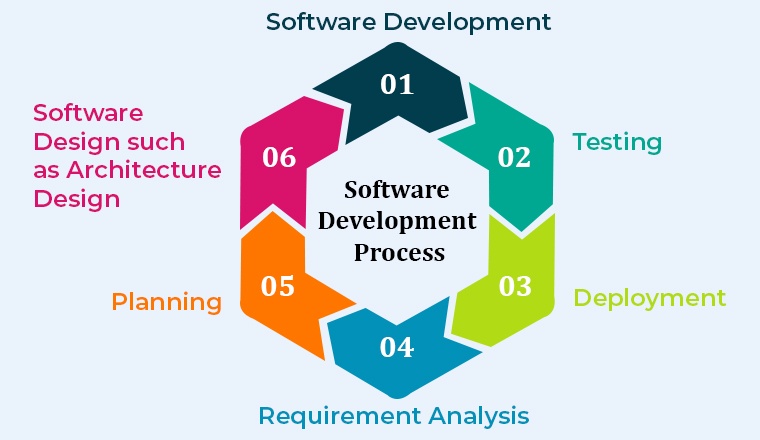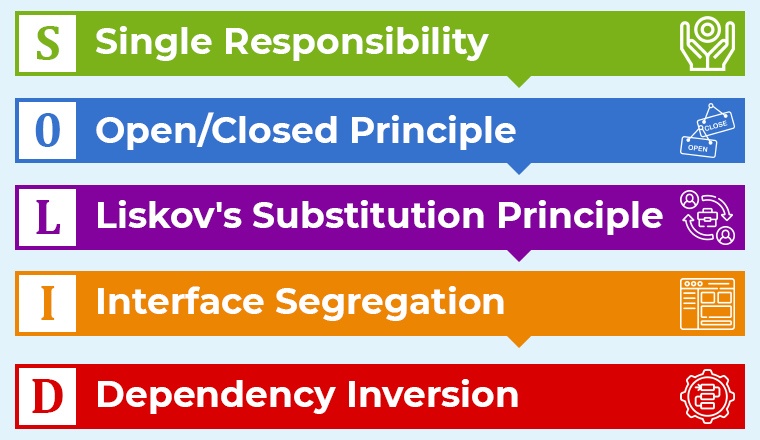
In the evolving tech world to create high-quality software solutions every software development service provider should be well acquainted with the knowledge of software development principles. This means that the application’s success is inevitably dependent on the software engineers’ willingness to use these best practices for software development introduced by some of the well-known and experienced industry experts.
There are many different software development principles that can help in creating an application by maintaining clean codes which can result in its success. These principles of software development should be constantly implied by software developers from time to time for the seamless evolvement of projects.
To know more about these software development principles, their usage, and implementation details, let’s go through this blog.
1. Software Engineering Process
The software engineering process comes with a set of guidance, education, and discipline which can be predictable. The engineering steps for each product will be the same but the time spent on each level will be different as per the team size and project goals. Basically, software engineering is a method that is used for the development of software solutions from the scratch.
The steps of this process are –
- Requirement Analysis
- Software Designing
- Creating Source Code
- Testing the System
- Post-deployment Maintenance

Basically, there are many software engineering process models and they vary as per the application, frequency, and implementation. Today we will just focus on 12 of the software principles.
2. Top Software Engineering Principles
Some of the top principles of software development are –
2.1 DRY (Don’t Repeat Yourself)
When the developer is writing a code, it is essential that he doesn’t repeat himself. Andy Hunt and Dave Thomas’ book The Pragmatic Programmer: From Journeyman to Master was the first to introduce this principle. This means that he has to avoid copy-pasting the code in various places in the program. In simple words, each piece of data should have a single source of truth (SSOT). This is primarily due to the necessity to further modify and maintain the code. This helps in solving future maintenance issues. If the developer doesn’t follow this rule, he will have to make changes to the coding in different places at later stages. And those changes will demand more changes when the system goes under testing. And this will take more effort, time, and money.
The following are some software engineering techniques that are based on the DRY principle:
- Inheritance and Composition
Inheritance and composition both allow you to write code once and then reuse it anywhere else.
- Database Normalization
Database normalization is a database design approach that eliminates data redundancy. In simple words, it avoids the repetition of data.
Therefore, it is advisable to extract common logic into different functions but not copy the same code.
2.2 Keep It Simple Stupid
While coding high-level modules for your next project, you must ensure that the programming language you choose is clear to understand and simple. The code must be simple and shouldn’t give difficulties to other developers when they have to change or modify it. Therefore, the methods used in coding must be small and each method used in programming must be able to solve at least one issue.
Therefore, the principle KISS (Always Keep It Simple, Stupid) must be followed. The main aim of this principle is to enable the developers to identify the bugs at the after rate and help them modify the code with ease.
2.3 SOLID

SOLID is a software development principle that stands for five design principles of object-oriented programming and designing.
- S stands for SRP (Single Responsibility Principle) – This principle of software development means that every class or module should come with its own responsibility for a single part of the feature offered in the software. Basically, the base class of the software must encapsulate the responsibility of a functionality.
- O stands for OCP (Open/Closed Principle) – OCP is a principle that specifies that software entities like functions, modules, or classes must be closed for modification but open for extension.
- L stands for Liskov Substitution Principle – It means that all the inherited classes are required to complement and not replace the base class’s behavior.
- I stands for Interface Segregation Principle – The interface segregation principle means that there is no customer who must be forced to depend on the software development methods it doesn’t use.
- D stands for Dependency Inversion Principle – This principle specifies that developers must not work at the implementation level but at the interface level.
2.4 You Aren’t Gonna Need It (YAGNI)

YAGNI is derived from a software development methodology called Extreme Programming (XP). Mostly all the software developers try to implement all the features and functionalities at once in the system and this is where the issue starts. For adding all the features at once, the programmer adds code that isn’t even necessary or that is not going to be useful in the near future and this makes the code be present in the system even if it isn’t required. So as per the YAGNI principle, if any such method or feature has been added, it must be removed while refactoring the system so that the developers can add useful features when the system starts taking a proper shape.
This principle is known as YAGNI. It helps in saving a lot of costs, time, and effort that goes behind understanding or debugging the code.
2.5 Avoid Premature Optimization
Generally, developers prefer to write code that is easy to maintain and understand. And because of this, the programmers might want to over-optimize the source code and make it faster. Optimized code can also use less memory. But in the case of premature optimization, the code can waste a lot of time. The reason behind it is that the developers avoid seeing what is actually happening. They optimize the code pre-maturely but it doesn’t turn out well as it is not perfectly ready.
So if the code is not perfectly ready and the programmer is not sure about the exact problem in the code, premature optimization is not an optimal approach.
2.6 Big Design Up Front (BDUF)
BDUF is a software engineering principle that confirms that a software developer completes the design of the project first and then implements it. This principle helps in discovering various issues at the requirement stage and solving it. But the changes in the software requirements that occur during the process can cause difficulties. Therefore, having a general architecture first before developing a functionality is very important. It enables setting priorities.
2.7 Dynamic Systems Development Method (DSDM)
DSDM (dynamic systems development method) is one of the most important principles when it comes to software development. It comes with three main factors that can be fixed beforehand. These three factors are known as time, cost, and quality. Besides this, the dynamic systems development method is something that embraces the MoSCoW prioritization approach for priority modification. And doing this results in timely delivery.
2.8 Fail Fast
Another principle of the software development process is “fail fast”. It is the most preferred approach by Silicon Valley. As per this concept, the software must crash if any error occurs. In this way, if any new programmers check the variable for a 0 or null value and try to continue the code even when it is not possible, an error should be shown by causing a crash. In the world of project management, this principle is known as a technical barrier that might come at the beginning stage of the project.
2.9 Occam’s Razor
William Occam, a philosopher of the 14th came up with a principle- “Entities are not to be multiplied without necessity” which was known as Occam’s Razor. As per this concept, one must select the hypotheses that have the fewest assumption. And to keep up with the lean software development process, the developer must always start the code with straightforwardness. And later on, they can add some complex modules such as method, class, tool, process or etc if needed. The main reason behind it is that the simple code enables easy development, testing, and correction of the product. In addition to this, it also helps in significantly reducing bugs.
2.10 ISP (Interface Segregation Principle)
Another software engineering principle in this list is Interface Segregation Principle (ISP). It means that a client must never be forced to completely depend on the software development methods. And this is possible by making the client-specific interfaces small and focused.
The developer must split large interfaces into smaller parts that mainly focus on specific functionalities that the client requires.
2.11 Dependency Inversion Principle
Dependency inversion is a principle that means that the software must have high cohesion and a low coupling system. As per this principle, the developers must not rely on concrete implementations but on abstraction. This means that the developers must see how the solution works instead of focusing on its creation.
2.12 Demeter
The Demeter principle states that the responsibilities of the software must be divided between classes and reduce coupling. By following this principle the developers can keep the entities of the software independent of each other. It also enables in reduction of the coupling or communication between different classes. Besides, the Demeter principle also puts related classes into the same module to achieve cohesion.
3. Conclusion
As seen in this blog, every pragmatic programmer must have a list of guiding principles that he can follow while creating software. This helps the developers in designing software in an effective manner. Software created using this type of principle is more efficient in serving the clients’ requirements.






I agree with the fact that implementing software development principles by the developers while writing the code is very important as it will help to maintain the quality of the software developed. Being a software developer you have mentioned all of the important software engineering principles that are useful for developers. It was a great read and I will surely share it with my colleagues.
After reading the article I realized that the Software engineering principles are a very important part of the software development process as they give developers guidelines for writing error-free, readable, and maintainable program code. Understanding all the 12 design principles was really very helpful. Thank you, writer.
Software Development Principles lead to the success of software development. Being a developer a software developer must know how to put development principles to use during the software development lifecycle as it allows developers to create maintainable code. I personally have used almost all of the principles mentioned in the blog.
For clean code software development, a developer must know software development principles. With the help of development principles in place, a developer can ultimately save on time, money and resources. Thank you so much writer for mentioning the importance of being a developer this would help me a lot.
the article provides practical tips and insights that are useful for anyone involved in software development. it focuses on the importance of collaboration, communication, quality assurance and testing formaking good software products.